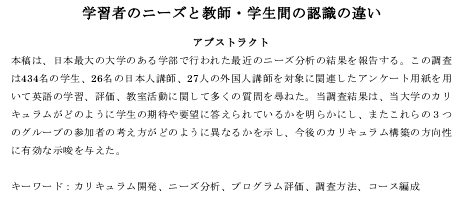Table 5.
Survey
Item # |
Statement |
Mean (SD)
[Adv] |
Mean (SD)
[Int] |
Mean (SD)
[Bas] |
| 1 |
I learn best in pair/group work. |
3.95 / (1.10) |
3.85 / (1.14) |
3.32 / (1.26) |
| 2 |
I learn best when working alone. |
3.07 / (1.01) |
3.11 / (1.14) |
3.17 / (1.07) |
| 3 |
I learn best with strict teaching. |
2.66 / (1.09) |
2.56 / (1.07) |
2.47 / (1.13) |
| 4 |
I learn best when following textbooks closely. |
3.08 / (1.14) |
3.33 / (1.14) |
3.56 / (1.03) |
| 5 |
I learn best with many tests and much homework. |
3.30 / (1.18) |
3.18 / (1.14) |
3.07 / (1.20) |
| 6 |
I learn best with Japanese explanations. |
2.68 / (1.19) |
3.34 / (1.23) |
3.71 / (1.18) |
| 7 |
I learn best with immediate error correction. |
4.12 / (0.91) |
3.89 / (1.02) |
3.72 / (0.95) |
| 8 |
I learn best with AV materials in language labs. |
3.18 / (1.30) |
3.15 / (1.22) |
3.38 / (1.23) |
| 9 |
I like to study grammar. |
3.07 / (1.16) |
3.17 / (1.23) |
3.09 / (1.10) |
| 10 |
I like when Ts help us individually in class. |
3.65 / (1.02) |
3.63 / (1.04) |
3.38 / (1.01) |
| 11 |
I like translation exercises. |
3.63 / (1.07) |
3.86 / (0.91) |
3.71 / (0.98) |
| 12 |
I like to choose my own group partners. |
2.93 / (1.09) |
3.35 / (1.07) |
3.52 / (1.08) |
| 13 |
I like to see words rather than hearing them. |
3.78 / (0.94) |
3.85 / (0.91) |
3.70 / (0.98) |
| 14 |
I like to try guessing answers. |
3.28 / (1.04) |
3.25 / (1.06) |
2.98 / (1.06) |
| 15 |
I prefer Japanese EFL teachers over native EFL teachers. |
2.32 / (1.07) |
2.89 / (1.05) |
3.13 / (1.01) |
| 16 |
I prefer to find out answers on my own. |
4.03 / (0.97) |
3.93 / (0.98) |
3.55 / (0.99) |
| 17 |
Having a friendly class atmosphere is important. |
3.90 / (1.16) |
3.77 / (1.11) |
3.55 v(1.10) |
| 18 |
I prefer to correct my own work. |
3.38 / (0.94) |
3.13 / (0.89) |
2.90 / (0.89) |
| 19 |
I like using video/TV in class. |
3.35 / (1.29) |
3.48 / (1.11) |
2.90 / (0.89) |
| 20 |
I like practice English outside of class. |
3.63 / (1.15) |
3.44 / (1.12) |
2.96 / (1.08) |
| 21 |
I like peer correction on writing work. |
3.58 / (1.14) |
3.44 / (1.07) |
3.17 / (0.93) |
| 22 |
I like to learn in classes that are fun. |
4.48 / (0.91) |
4.33 / (0.89) |
3.93 / (1.11) |
| 23 |
I like homework using radio/newspaper. |
3.28 / (1.20) |
2.97 / (1.15) |
2.74 / (1.13) |
| 24 |
I like talking with classmates in English. |
3.37 / (1.24) |
3.19 / (1.12) |
2.80 / (1.10) |
| 25 |
I like choosing class work on my own. |
4.03 / (1.04) |
4.17 / (0.94) |
3.94 / (1.14) |
| 26 |
I prefer working in same gender pairs/groups. |
3.40 / (0.92) |
3.45 / (0.93) |
3.41 / (0.91) |
| 27 |
I like learning English as in high school. |
3.40 / (0.92) |
3.45 / (0.93) |
3.41 / (0.91) |
| 28 |
I like studying in language labs / library. |
2.92 / (1.37) |
2.66 / (1.24) |
2.80 / (1.34) |
Table 6.
Survey
Item # |
Statement |
Mean
(Adv) |
Mean
(Int) |
Mean
(Bas) |
| 73 |
I prefer short quizzes to term tests. |
3.78 / (1.02) |
3.78 / (1.16) |
3.74 / (1.19) |
| 74 |
I do better on grammar tests than on tests of communication. |
2.90 / (1.28) |
3.18 / (1.22) |
3.12 / (1.05) |
| 75 |
I want to learn test taking strategies. |
3.54 / (1.13) |
3.93 / (1.11) |
3.94 / (1.10) |
| 76 |
I prefer computer-based tests. |
2.63 / (1.08) |
2.85 / (1.18) |
2.90 / (1.12) |
| 77 |
I prefer Essay tests. |
2.73 / (1.11) |
2.69 / (1.10) |
2.64 / (1.13) |
| 78 |
I prefer annual oral tests |
3.36 / (1.17) |
3.15 / (1.18) |
2.69 / (1.18) |
| 79 |
I plan to take an English proficiency test soon. |
3.05 / (1.64) |
2.91 / (1.38) |
2.39 / (1.27) |
| 80 |
I want to learn how to improve my G-TELP score. |
3.32 / (1.46) |
3.67 / (1.25) |
3.38 / (1.23) |
| 81 |
I concerned about failing grades. |
3.25 / (1.39) |
3.45 / (1.38) |
3.56 / (1.34) |
| 82 |
I want to achieve the highest possible grades. |
4.20 / (1.22) |
4.43 / (0.95) |
4.13 / (1.17) |


 PDF Version
PDF Version



